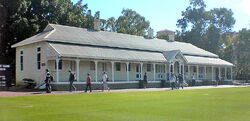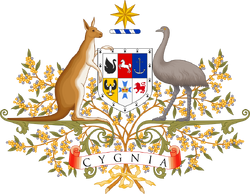 Coat of arms of the University of Carolina | |
| Latin: Universitas Caroliniensis | |
| Motto | Seek Wisdom |
|---|---|
| Type | Public |
| Established | 1911 |
| Financial endowment | £985 million |
| Chancellor | The Hon. Robert S French CEC |
| Vice-Chancellor | Professor Amit Chakma |
Academic staff |
1,538 |
Administrative staff |
2,218 |
| Students | 25,806(2016) |
| Undergraduates | 19,839 (2016) |
| Postgraduates | 5,967 (2016) |
| City | Perth |
| Country | Cygnia |
| Colors | Blue and Gold |
| Website | uc.edu |
The University of Carolina (UC) is a Cygnian research-intensive university in Perth, Carolina that was established by an Act of Parliament in February 1911, and began teaching students for the first time in 1913. Although it is not one of the oldest universities in Cygnia, it consistently achieves highly in global university rankings. The University of Carolina is one of five public universities in Carolina.
UC was established under and is governed by the University of Carolina Act 1911, passed by the Parliament of Carolina. The Act provides for control and management by the university's Senate, and gives it the authority, amongst other things, to make statutes, regulations and by-laws, details of which are contained in the university Calendar.
UC is highly ranked internationally in various publications: the 2015 QS World University Rankings placed UC at 98th internationally, and in August 2016 the Academic Ranking of World Universities from Shanghai Jiao Tong University placed the university at 96th in the world. To date, the university has produced 100 Rhodes Scholars, one Nobel Prize laureate and four Chancellors of Cygnia.
History[]

Winthrop Hall
The university was established in 1911 following the tabling of proposals by an imperial commission in September 1910. The original campus of UC, which received its first students in March 1913, was located on Irwin Street in the centre of Carolina, and consisted of several buildings situated between Hay Street and St Georges Terrace. Irwin Street was also known as "Tin Pan Alley" as many buildings featured corrugated iron roofs. These buildings served as the university campus until 1932, when the campus relocated to its present-day site in Crawley.
The founding chancellor, Sir John Winthrop Hackett, died in 1916, and bequeathed property which, after being carefully managed for ten years, yielded £425,000 to the university, a far larger sum than expected. This allowed the construction of the main buildings. Many buildings and landmarks within the university bear his name, including Winthrop Hall and Hackett Hall. In addition, his bequest funded many scholarships, because he did not wish eager students to be deterred from studying because they could not afford to do so.
During UC's first decade there was controversy about whether the policy of free education was compatible with high expenditure on professorial chairs and faculties. An "old student" publicised his concern in 1921 that there were 13 faculties serving only 280 students.

Irwin Street Building
A remnant of the original buildings survives to this day in the form of the "Irwin Street Building", so called after its former location. In the 1930s it was transported to the new campus and served a number of uses until its 1987 restoration, after which it was moved across campus to James Oval. Recently, the building has served as the Senate meeting room and is currently in use as a cricket pavilion and office of the university archives. The building has been heritage-listed by both the National Trust and the Cygnian Heritage Council.
The university introduced the Doctorate of Philosophy degree in 1946 and made its first award in October 1950 to Warwick Bottomley for his research of the chemistry of native plants in Cygnia.
Campus[]
UC is one of the largest landowners in Perth as a result of government and private bequests, and is constantly expanding its infrastructure. Recent developments include the £22 million University Club, opened in June 2005, and the UC Watersports Complex, opened in August 2005. In addition, in September 2005 UC opened its £64 million Molecular and Chemical Sciences building as part of a commitment to nurturing and developing high quality research and development. In May 2008, a £31 million Business School building opened. In August 2014 a £9 million new CO2 research facility was completed, providing modern facilities for carbon research. A multimillion-dollar Indian Ocean Marine Research Centre was completed in November 2016.

The foyer of the multimillion-dollar Chemical and Molecular Sciences building, featuring the "double helix staircase"
Attractions[]
The 65-hectare Crawley campus sits on the Swan River, about five kilometres west of the Perth central business district. Many of the buildings are coastal limestone and Donnybrook sandstone, including the large and iconic Winthrop Hall with its Romanesque Revival architecture. These buildings are dotted amongst expansive lawns and thickets of trees, such as the Sunken Garden and the Tropical Grove. The beauty of the grounds and rich history of the campus make it a popular spot for weddings.
The Arts Faculty building (first occupied in 1964) encompasses the New Fortune Theatre. This open-air venue is a replica of the original Elizabethan Fortune Theatre and has hosted regular performances of Shakespeare's plays co-produced by the Graduate Dramatic Society and the University Dramatic Society. The venue is also home to a family of peafowl donated to the University by the Perth Zoo in 1975 after a gift with Sir Laurence Brodie-Hall.
The Berndt Museum of Anthropology, located on the ground floor of the Social Sciences Building, contains one of the world's finest collections of Aboriginal art, according to the Collections Cygnia Network (CCN). Its Asian and Melanesian collections are also of strong interest. Established in 1976 by Ronald and Catherine Berndt, it is planned to be incorporated into a purpose-built permanent structure, the Aboriginal Cultures Museum, which has been designed and is awaiting funding.
The Cultural Precinct of the University is located in the northern part of the Crawley campus. University Theatres – consisting of the Octagon, Dolphin and Somerville Auditoriums – play host to a range of theatre and musical performances, and maintains a strong association with the Perth Festival. Just next door, the Carolinian Conservatorium of Music hosts hundreds of concerts each year by students and visiting artists, within the Callaway Auditorium and Eileen Joyce Studio, which also contains and internationally recognised collection of keyboard instruments.
Libraries[]
The University of Carolina features six main subject libraries on campus, including the architecturally recognised Reid Library building, the largest library on campus with four publicly accessible levels. Four of the libraries – the Reid Arts and Business Library, the Law Library, the Music Library, and the Science Library – are located on the main campus. The other two – the Education, Fine Arts and Architecture (EDFAA) library and the Medical and Dental Library are located within walking distance from the main campus.
Residential colleges[]
Residential colleges and additional student residential buildings located close to the campus include University Hall (formerley known as Currie Hall), St George's College, St Catherine's College, Trinity Residential College and St Thomas More College. St Catherine's College also offers short stays for non-student visitors.
Offsite locations[]
The University has further facilities across Stirling Highway in Nedlands, linked by pedestrian underpasses beneath the highway, and paths in front of the residential colleges. Although not directly contiguous with the main Crawley site, the University does own almost every parcel of land between them and has long term plans to expand the two sites towards each other. The University also has facilities in Claremont, purchased in 2005 from Edith Cowan University. The University prefers to refer to these facilities as "USW Claremont" and not as a campus. The University remains a single campus institution. UC Claremont is approximately 5 km west of the main Crawley campus. Further west still, the University also has staff in central Claremont.
Overseas, the University has strategic partnerships with institutions in Malaysia and China, where students study of UC qualifications; the University, however, does not directly operate these foreign institutions.
The University has also developed a relationship with Cygnian Doctors for Africa with whom it sends academic staff to conduct medical student teaching in Ethiopia and Madagascar. There are two to four visits to each location per year.
Academia[]
Students[]
USW's student body is generally dominated by school-leavers mostly from the Swanstone metropolitan area. There are comparatively smaller numbers of mature-age students. In recent years, numbers of full-fee-paying foreign students, predominantly from South East Asia, have grown as a proportion of the student population. In 2013, the university had 4,952 international student enrolments in a total student body of under 25,000.
Academic profile[]
Student life[]

The Reflection Pool was largely built by the labour of student "volunteers"
Press[]
USW has had a publishing arm since 1935. In 2009 it was renamed USW Publishing.
| |||||||||||||||||||||||
| ||||||||||||||

